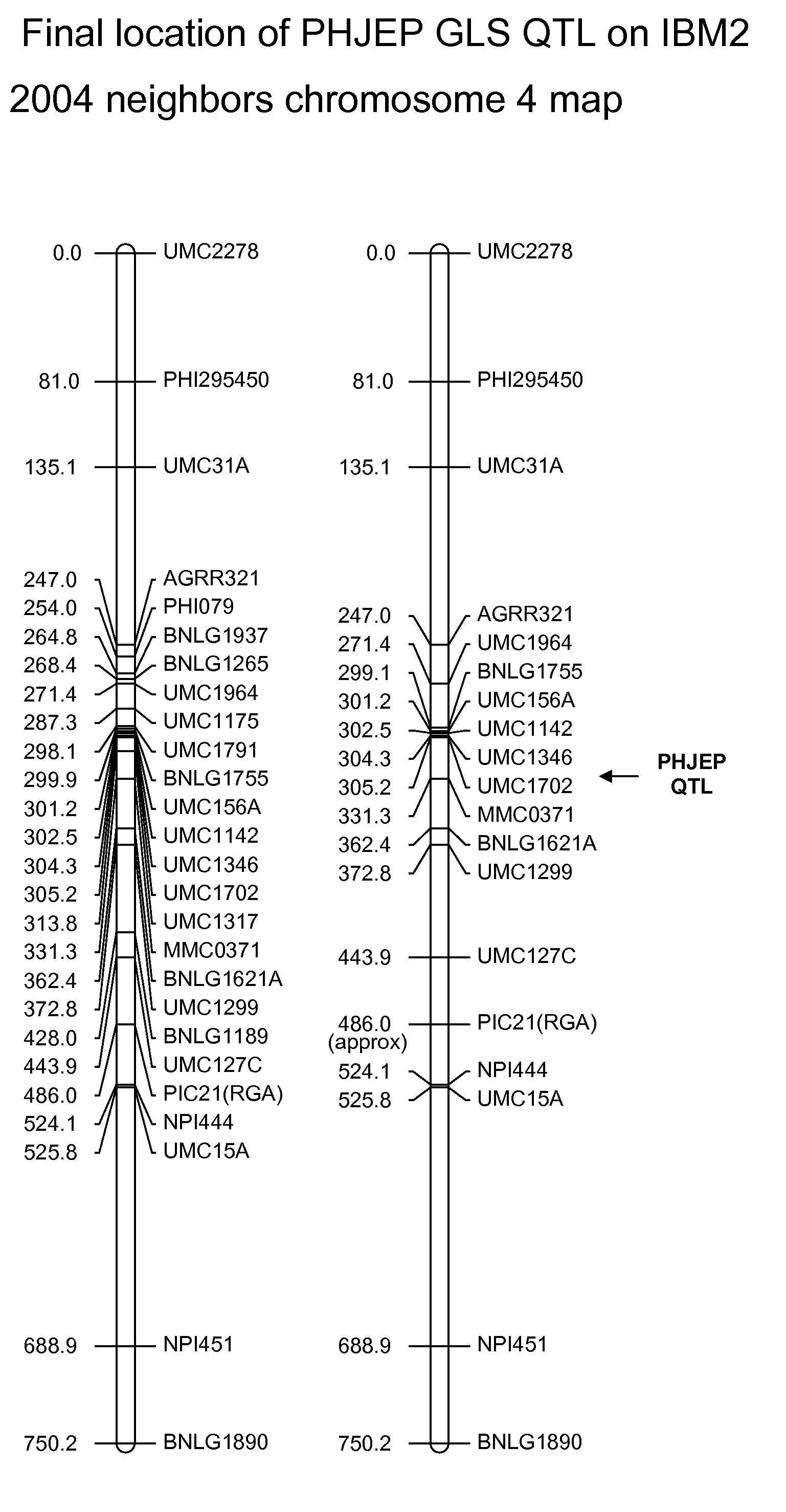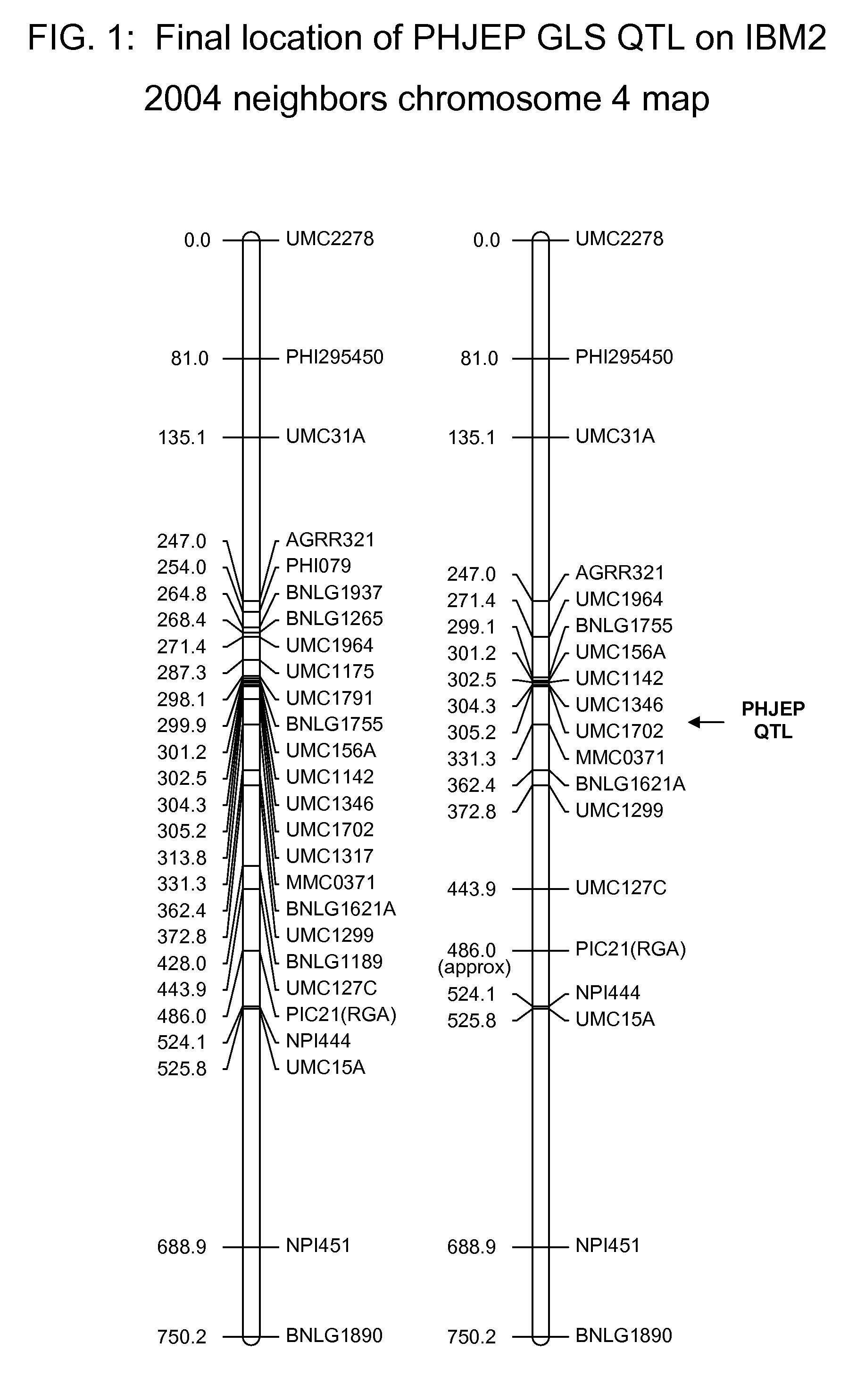Gray leaf spot tolerant maize and methods of production
a technology of tolerant maize and grain spots, applied in the field of tolerant grain spots (gls) maize plants, can solve the problems of reduced yield, premature senescence, and loss of photosynthetic area, and achieve the effects of reducing senescence, enhancing tolerance, and improving yield
- Summary
- Abstract
- Description
- Claims
- Application Information
AI Technical Summary
Benefits of technology
Problems solved by technology
Method used
Image
Examples
example 1
Mapping a Large Effect QTL for GLS Tolerance
[0346]The GLS source of tolerance is uncommon in North American (NA) germplasm. To create an elite line for use as a donor source for GLS tolerance, the GLS tolerant line PH14T (U.S. Pat. No. 5,942,670) was crossed to PHN46 (U.S. Pat. No. 5,567,861) in order to generate an F1 population. Individuals of the F1 population were later backcrossed to PHN46 to generate a BC5 backcross population of approximately 190 individuals.
[0347]The F1 populations were phenotyped in the field for GLS tolerance. Marker data was collected on each progeny individual using SSR markers, with good genome coverage to generate a molecular marker map for the population. QTL analysis of the data from the F1 population identified a QTL for GLS tolerance on Chromosome 4, bin 5, between markers UMC1791 and UMC1346.
[0348]The BC5 population was also phenotyped in the field for GLS resistance. Marker data was collected on each progeny individual using SSR markers, with goo...
example 2
Fine Mapping of the QTL for GLS Tolerance
[0349]The integrated genetic and physical map of maize was used to identify all BAC contigs located in the region. Low-copy BAC ends sequences and PHM markers from these contigs were used to develop CAPS markers. It was determined that bacm2.pk027.h10.f and bacm.pk098.d7 flank the GLS locus on one side, and bacm.pk022.b8 and PHM 7245 flank on the other side.
example 3
Development of PHJEP
[0350]A progeny individual derived from the BC4 generation that had the QTL region, a phenotype most like PHN46, and a good resistance phenotype was selected. The individual was selfed to ensure a largely homozygous genome. The resulting inbred was designated PHJEP. The introgression of the GLS QTL resulted in a disease resistance score for PHJEP of 4 (on a scale of 1-9) compared to 1 or 2 for PHN46. FIG. 6 demonstrates the phenotypic difference between PHN46 and PH14T following inoculation with Cercospora zeae-maydis.
[0351]The QTL was further backcrossed into PHN46. A progeny individual derived from the BC7 (dose 8) generation was selected that had the newly defined QTL region and a smaller segment of donor in the region immediately flanking the QTL. The individual was selfed to ensure a largely homozygous genome. The resulting inbreds were coded PHW6N and PHW6M. These inbreds were found to have GLS tolerance levels equivalent to PH14T and PHJEP. Since PHJEP wa...
PUM
| Property | Measurement | Unit |
|---|---|---|
| Magnetic field | aaaaa | aaaaa |
| Electric charge | aaaaa | aaaaa |
| Electric charge | aaaaa | aaaaa |
Abstract
Description
Claims
Application Information
 Login to View More
Login to View More - R&D
- Intellectual Property
- Life Sciences
- Materials
- Tech Scout
- Unparalleled Data Quality
- Higher Quality Content
- 60% Fewer Hallucinations
Browse by: Latest US Patents, China's latest patents, Technical Efficacy Thesaurus, Application Domain, Technology Topic, Popular Technical Reports.
© 2025 PatSnap. All rights reserved.Legal|Privacy policy|Modern Slavery Act Transparency Statement|Sitemap|About US| Contact US: help@patsnap.com



